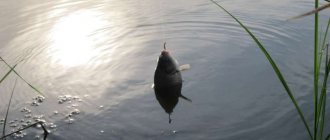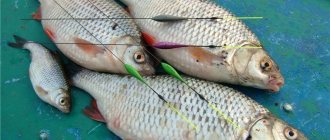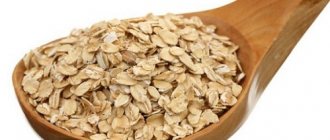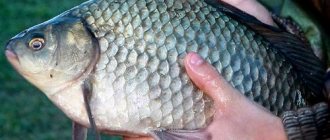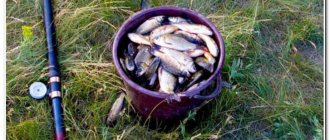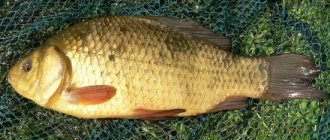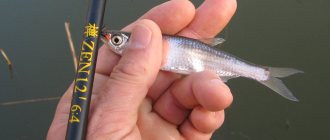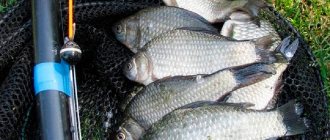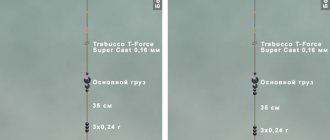Peculiarities of behavior of crucian carp in August
In the first half of August, large crucian carp move along the bottom depressions, which still contain enough plant food, bottom larvae and aquatic invertebrate inhabitants. Crucians weighing up to 150 g move in coastal silty areas overgrown with algae and lush coastal vegetation: reeds, reeds or cattails.
From the second half of the month, the food supply begins to gradually decrease. In reservoirs with a large population of crucian carp, competition for food begins. Schools of fish weighing about 500 g quickly “clean up” one area and move to another place with food available. If pike does not live in a lake, pond or section of a small river, then crucian carp is found everywhere. It can concentrate in flocks in reed thickets growing near the shore.
Reasons for lack of bite
Since August is a rather difficult month for crucian carp, characterized by changes in weather, pressure and other indicators, it may well happen that you return from fishing with nothing.
Did you know? There is an opinion that the bite of crucian carp largely depends on what phase the Moon is in. The most successful fishing will be during the waning moon and on the new moon.
The reasons for this can be varied, namely:
- increased atmospheric pressure or its sudden changes;
- incorrect choice of nozzle that is not suitable for the conditions of the reservoir;
- strong wind;
- excessively hot days in the first half of August or very cold days in the second;
- an inappropriate place, for example, fishing in reed thickets at the end of summer will not bring anything good.
It should also be taken into account that the bite during the day is greatly influenced by the presence of other representatives of aquatic fauna in the reservoir. For example, if there is a pike in the river, the crucian carp will go out to feed exclusively at night, when it practically does not notice its proximity to the predator.
Inexperienced fishermen often think that crucian carp is a capricious fish. Actually this is not true. If you choose the right gear, bait and determine a good place, catching it will not be difficult. In addition, the process will bring a lot of pleasure, especially if you fish with hand-made equipment.
Where to look for crucian carp in August
Signs of a promising place for catching crucian carp in August:
- Pits on the silted bottom, overgrown with algae, near reeds or reeds. This feature is good when fishing on rivers and in reservoirs with stagnant water;
- River bays. You need to choose a place on an area with a steeper bank;
- The presence of trees, parts of the crowns of which hang over the water;
- The bends of the river bed. A sufficient amount of food is constantly carried out to such areas by the current. Crucian carp “remembers” areas with a “set table”;
- Islands of reeds. Behind such islands on the rivers a slow or counter current is formed. This is where you should cast;
- Mouths of tributaries;
- Wide channels with slow flow. In narrow fast-flowing channels, crucian carp periodically appears, but, as a rule, does not linger;
- Boundaries of emergent plants and algae. An excellent sign is the presence of water lilies;
- Areas with differences in depth.
If there is at least one sign of a promising place for fishing for crucian carp, you can start catching it. In August, crucian carp can be caught day and night from the shore or boat. To catch it, a float rod, feeder, fly fishing and elastic tackle are often used.

Large crucian carp
Catching large crucian carp on a feeder requires additional tactics and technique from the angler. Often on reservoirs a situation arises when a large school of small crucian carp comes to a point, but a large one is not caught, although it is known for sure that it is there. The big fat one does not like the rush created by the larger population of its smaller brother. It’s not that he’s afraid – it’s just that adults are more experienced in conserving energy and don’t want to waste it swimming in a crowd.
However, if a small one bites, that means that the aromatics and the bait are working. Adults usually do not climb into the center of this mass, but slowly cruise nearby, along the boundaries of the feeding spot. Therefore, if you want to catch a fat big fish weighing a kilogram or more, we periodically cast the feeder to the left, to the right and closer to the feeding area. Moreover, we do this with an empty feeder so as not to smear the point.
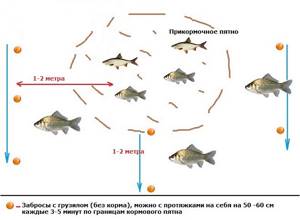
Fishing scheme at the border of a feeding spot in still water
For example, we throw the feeder at the same distance (so as not to overclip) to the left or to the right a meter or two, to the border of the stern zone. Sometimes the pulling technique works - we drag the feeder equipment half a meter towards us every 3-5 minutes. In this case, bites will become less frequent, but with a high degree of probability it will be the large fish that will take it.
In a current we do the same thing, but taking into account the direction of the flow. Large individuals usually stand slightly lower in the feeding stream. Therefore, in a similar way, if we are fishing on a river, we check with a feeder from a point to the side in the direction of the flow 2-5 meters below.
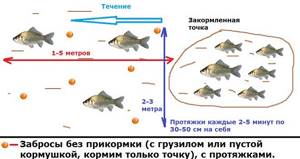
Scheme of fishing the border of the feeding zone on the current
Fishing for crucian carp in August using a float rod
The float fishing rod has not lost popularity over the years. It remains the most popular tackle for catching crucian carp. In order for catching crucian carp in August with a float rod to be effective, you should assemble the gear correctly. The equipment should be sensitive and facilitate timely detection of the beginning of a crucian bite.
Any rod that allows you to cast to the required distance is suitable. The optimal length of the Bolognese fishing rod is 2.7 m. This rod is convenient for fishing from the shore and boat. The maximum casting distance can be increased by equipping the fishing rod with a sliding float. Match fishing rods, as well as fly rods, are applicable. Any convenient coil can be installed, but you can do without it.
Fishing place
With the approach of autumn, and in August this is already felt, the crucian carp begins to gradually move away from the shore and go to deeper places. Therefore, you can catch it with a fishing rod with float tackle and a limited casting range only where the depth reaches 1.5-2 meters. However, you can find a lot of such places on lakes, in a favorite pond or in oxbow lakes. Loaded areas also remain a priority.
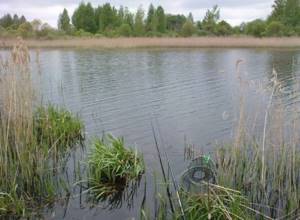
If there is a decline in depth beyond the edge of the vegetation, there should be crucian carp there
But on warm days, especially if there was no cold snap at night, crucian carp can still be found among the vegetation. Even in a small window in the grass, where you can carefully deliver the tackle, you can catch a dozen decent fish, or even pull out a trophy specimen.
What do crucian carp bite on in August?
Practice shows that crucian carp in August more often bites on bait of animal origin:
- Red dung worm;
- Bloodworm;
- Maggot;
- Caddisfly larva.
These are the most popular and affordable baits for crucian carp. Silicone analogues of popular baits are also applicable.
But it is impossible to foresee the most catchy bait in advance. The fish shows its whims at any time of the year. You should also have different plant fishing baits in your arsenal. Often a “sandwich” on the hook consisting of bait and vegetable bait works well. Experiments with bait are relevant when fishing for crucian carp in August using a float rod, feeder and elastic band.
Lure
Catching crucian carp on a feeder with a feeder requires the mandatory use of bait, although it won’t hurt without a feeder either. But not just any bait is suitable for such fishing; it is very important to choose the right composition. You can buy ready-made store bait or make it yourself
, guided by the recipes below. But first, a little theory.
In summer, fish prefer plant foods, but do not refuse baits of animal origin (worms, bloodworms and maggots). Therefore, it is better to include animal and plant elements in the summer bait.
Nobody forbids you to go to the store and buy a ready-made bait mixture, and when you arrive at the pond, simply add water to it. But the price is quite high, and it is not always possible to find what you want. Therefore, preparing bait at home is much more convenient and economical.
.

There are a lot of feeder bait recipes for crucian carp. All reservoirs differ from each other, as do the preferences of the fish in them, so the bait recipe can be changed due to the individual characteristics of the fish’s preferences. We decided to choose the TOP 3 best bait and provide you with its recipes.
A universal bait is considered to be a mixture of corn flour and boiled pearl barley with the addition of wheat or wheat cereal. The wheat must be boiled for 15 minutes (as soon as the grains begin to open, this means the porridge is ready). After cooking, you need to drain the water from the pan and rinse the entire mixture several times with running cold water (this is necessary to ensure that the grains do not stick together). Now boil the pearl barley and mix it with wheat. To prevent the bait from turning sour, add flour upon arrival at the pond.
The basis of the following bait recipe is potatoes. The preparation is very simple: boil about 7-10 medium-sized potatoes, mash so that there are no large lumps and add makukha or fish feed. Now stir the resulting mixture and add water to it if necessary.
The basis of the following bait mixture is steamed oat, wheat and hemp grains. Which need to be mixed in one bowl and added to them is flour with various attractants. At an average fishing rate, 2.5 kilograms of this complementary food was enough for me.
Additives to bait
To enhance the effect of using food, some fishermen add bite activators to it, and some recommend using various flavors of natural origin. Over the years, fishermen have experimentally found out what smells attract crucian carp to the feeder and it turned out that they react positively to the smells:
- garlic;
- anise oil;
- cinnamon;
- sunflower oil;
- vanillin;
- linseed oil;
- cocoa.
Fishing for crucian carp in August on a feeder
To hunt for a trophy specimen, crucian carp fishing is used in August on a feeder. At night, the probability of catching individuals weighing more than 1 kg increases. It is important to properly equip the feeder. In addition to classic feeder equipment, equipment with two or three springs attached in series is characterized by high catchability. Springs 2-3 cm long with a diameter of about 1 cm are selected. A short leash of up to 5 cm is tied near each spring. To ensure the required casting distance, a sinker is tied below the springs. The equipment is attached to the main line using a swivel, which acts as an anti-twist. Such equipment is now available for sale. In the fishing community, the rig is called the “crucian carp killer.” It should be noted that, despite the name, this equipment has nothing in common with poaching equipment.
Fly fishing for crucian carp in August
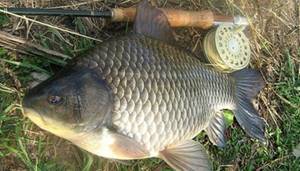
In reservoirs with a large population, fly fishing for crucian carp is used in August. Fly fishing requires the selection of bait with appropriate buoyancy and special fishing. To catch palm-sized crucian carp, wet flies are used, which allow them to be guided through the water column. Large fish are caught using fast-sinking flies.
There are no special requirements for fly fishing gear to catch crucian carp. The main thing is to deliver the bait to the intended place.
Features of fly fishing for crucian carp in August:
- To increase the casting radius, fishing is carried out by wading;
- It is important to wire the artificial front sight correctly. This is due to the fact that the fish react visually to baits without flavorings or determine its location by the lateral line. Short pull-ups are performed, alternating with pauses of 20-30 seconds;
- The crucian carp confidently grabs the “running away” fly, and its bite is well transmitted through the rod;
- When fishing in the current, you can use fusion bait. The cast is made upstream, and the bait floats in the water column. This fishing method is applicable in slow currents. Crucian carp is not found on rapids.
When fishing by wading, you should have a landing net with you. It will be needed to remove individuals weighing 800 grams or more from the water. Smaller crucian carp can be caught without any problems.
Choosing feeder equipment for fishing
When catching crucian carp on a feeder, the choice of one or another feeder equipment depends on the fishing conditions and the intensity of the fish’s bite:
- When fishing for crucian carp in shallow reservoirs with a muddy bottom, it is best to use paternoster and Gardner loop rigs.
- If the crucian carp is inactive and its bites are weak and barely noticeable, then it is better to use more sensitive equipment - an asymmetrical and symmetrical loop.
- The crucian killer tackle catches active fish well when fishing in small shallow water bodies with a depth of up to 2 meters.
There is no float for feeder fishing.
Line selection
When fishing for crucian carp at short distances, a strong monofilament line with a cross-section of 0.2-0.3 mm is most often used.
When fishing in large bodies of water, where the equipment is cast over long distances, a durable and inextensible braided cord with a thickness of 0.1-0.16 mm is more preferable.
Coil selection
Daiwa Infinity-X 5500BR
One of the best feeder reels. Thanks to the small-profile spool, the side of which is made of wear-resistant titanium coated with metal ceramics, the reel is able to accommodate a sufficient supply of fishing line or braided cord and cast it well, thereby ensuring long casts. The reel is equipped with 5 reliable bearings, a convenient and easy to switch baitrunner. All reel parts have an anti-corrosion protective layer.
Shimano Catana 2500 FC
Thanks to the line control system, the reel has a smooth run and winds the line in even turns, is equipped with 3 bearings (2 ball and 1 roller), and a front clutch. In addition, the model is equipped with a reliable system that blocks the reverse rotation of the spool.
In addition to the capacious aluminum reel used for braided cord, the reel also comes with a durable graphite spool for monofilament fishing line.
Ryobi ECUSIMA 3000
A powerful and durable reel that successfully competes with more famous brands in terms of quality, while being more affordable.
The reel body is made of light and durable alloy, the internal mechanisms are balanced, the reel is equipped with 5 bearings, a reliable and finely adjustable front clutch, and a spacious metal spool.
Ryobi ECUSIMA 3000 Daiwa Infinity-X 5500BR Shimano Catana 2500 FC
Leash
For feeder fishing for crucian carp, a leash is important. An incorrectly selected length and cross-section of this element of the tackle can lead to the loss of large fish and frequent breaks of the leash with weak hooks.
- For catching crucian carp, high-quality and durable monofilament fishing line with a cross-section of 0.14-0.18 mm is most often used.
- The length of the leash is chosen depending on the type of equipment used and it ranges from 40 to 80 cm.
- When choosing the length, it is important to take into account the possibility of a very long leash catching when casting behind a feeder, bushes, or ground.
Hooks
The size of the hook for the feeder depends both on the size of the fish and on what kind of bait you plan to use
When catching large crucian carp and using worms as bait, large hooks No. 10-12 with a long shank are used.
If corn, peas, or undercooked potatoes are used as bait, then use smaller hooks No. 14-16.
Among the huge range of hooks used for feeder fishing, the following models are the most reliable:
Mustad Nickel Bream Feeder 60332N/LP54 Owner cut chinu

Owner iseama 50046
Feeder
All feeder feeders can be divided into several types depending on their design features, load, and area of application.
Mesh feeders, or as they are often called “cages,” are the most common feeder feeders today. The design is a mesh frame with a fixed lead weighting plate.
According to the cross-sectional shape, such feeders are:
- Square;
- Rectangular;
- Round;
- Triangular.
Round feeders hold the bottom more effectively when fishing in still water and in weak currents; square, triangular and rectangular feeders, due to the large area of contact with the bottom soil, are more suitable for fishing in medium and strong currents.
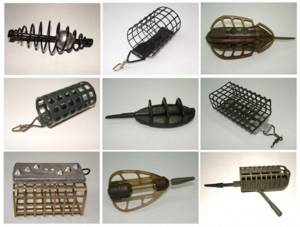
In addition to the shape and weight of the weighting material, mesh feeders differ in the degree of leaching of the feed mixture in an abandoned feeder. According to this feature they are:
- Open - there are no partitions in the feeder and when the feeder hits the bottom, the bait spills out freely through the ends. Such feeders are used when fishing in still water.
- Semi-closed - the end opposite to the one on which the feeder mount is mounted is covered with a plastic partition. As a result, the bait does not spill out of the feeder, but is washed away by the current, forming a feeding path. Used during currents.
- In addition to mesh feeders, there are also spiral (“springs”) - a hollow rod with a wire spiral wound in a spindle-shaped manner. Such feeders are not weighted; they are located quite freely on the fishing line, moving between the stop bead and the swivel or lower leash assembly. They are used due to the lack of additional weight for fishing in still water.
Catching crucian carp in August with an elastic band
On the gently sloping bank, successful fishing for crucian carp is possible in August using an elastic band. The classic rubber band rig is used. Fishing with a rubber band from a boat is possible. To attract fish to the location of the bait, you can equip the rubber band with a feeder.
It should be noted that with a successful choice of place for catching crucian carp in August, fishing will be full of frequent bites. During the low-biting period, you can cook on the shore or relax a little. Crucian carp usually return to feeding areas, and you won’t be bored.
Groundbait and bait
Fishing in August will be successful if the bait and bait are chosen correctly. Experienced fishermen usually practice feeding the fish in advance. For example, they plan to go to a reservoir in the morning, and in the evening they add food additives so that more crucian carp accumulate in a particular place. Complementary feeding from special mixtures that are bought in the store, or from cake mixed with steamed wheat grains and chopped worms, works best.
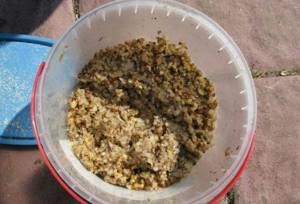
The correct bait for crucian carp during this period should combine plant and animal elements. For this purpose, it is advantageous for the tackle to include 2 hooks. Then a worm or bloodworm is placed on the first one, and a piece of rye bread on the second.
